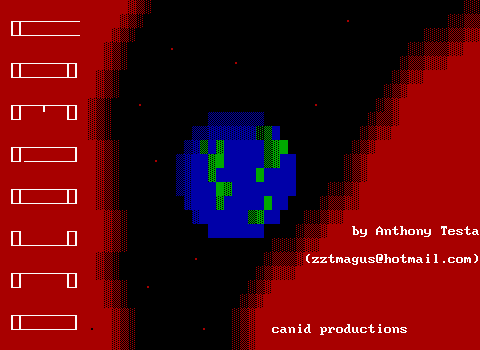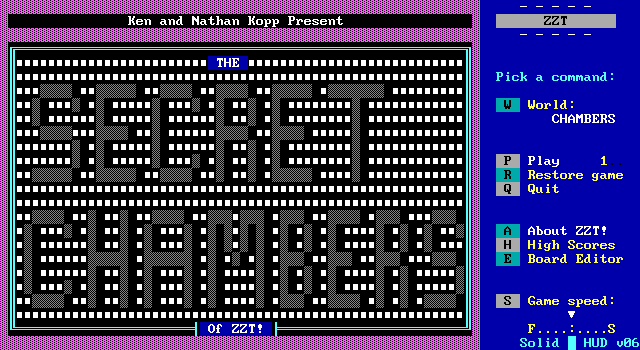
I'm a big proponent of that Holy Shit! Two Cakes! meme. That fear of not being good enough or being lesser because somebody else out there is also making the sort of thing that you're making is a real one for a lot of folks. It's very much relatable from the audience's perspective as well. Lord knows how many of my YouTube subscriptions stemmed from running out of videos on one channel leading me to find more and more folks with similar creations to keep watching more of that content I crave.
The poll winner for this month was Ken and Nathan Kopp's The Secret Chambers of ZZT. The two authors, of whom no information is available, are here to put their second smaller, messier cake on the table. This game is so incredibly derivative of Town of ZZT and Monster Zoo that it's kind of astonishing.
So ZZT It Hurts

When you begin the game, this is the first board you see. Not knowing what to really expect, I was quickly on board. This is clearly a hub styled after the start of Monster Zoo. So yeah, things are derivative from the very onset of the adventure, but that's not a bad thing. While ZZT worlds would influence numerous Super ZZT worlds, the reverse hasn't really happened. I was looking forward to where this was going to go. There's no real reason a ZZT game styled after the official Super ZZT worlds couldn't work. I was really curious about how much influence I'd be in for, and how that would shake out.
I suspect it's just a matter of necessity. While 1997 is still well within ZZT and Super ZZT's first decade of existence, it's a bit late for a game so directly styled after the original games. 1997 is the year I found ZZT and Super ZZT and I can imagine the authors had a similar experience to my own: Getting the games off an old shareware CD, enjoying Monster Zoo more than Town, but then realizing ZZT had an editor readily available while Super ZZT did not. And when your only idea as to what a (Super) ZZT game is comes from the shareware releases, it should come as no surprise that the idea sticks heavily to the style of what you've seen. The reality is likely a little more complex, as there are enough touches from some of the other worlds as well, but Epic MegaGames is by far where a huge chunk of this game's influence stemmed from.
Going through this adventure, I was really surprised at how just formulaic it seemed. The first half of Secret Chambers comes off as one of the most uninspired ZZT games I've ever played. It's so afraid to step out of ZZT's shadow and allow itself to present new ideas that it gets tedious and unfun. Yet at the same time, I can't really pinpoint anything wrong here. (I mean okay there are some instant game overs that are pretty easy to blame, but they're few and far between.) No individual rooms are bad, it's just when taken as a whole you realize you're treading water. Every board just happens to be here with no real reason. Shuffle them around, or take a few out and you wouldn't change the overall experience at all.
It's very much Town and Zoo, yes, but what those games have that Secret Chambers struggles to emulate is with getting anything to stick. When you think of Town you think of "Ecch! Bugs! Lookout!" or "The Rube Board". The Kopp duo has a lot of difficulty in creating memorable boards, and rather than capture the spirit of the classics at their best, they instead capture the lesser "filler" feeling boards like "The Cave" or "Labrynth 1" [sic]. As just one of dozens of boards in Town, they're overlooked for their more fanciful brethren. Turn an entire game into this kind of board and you're going to get tired of it eventually.
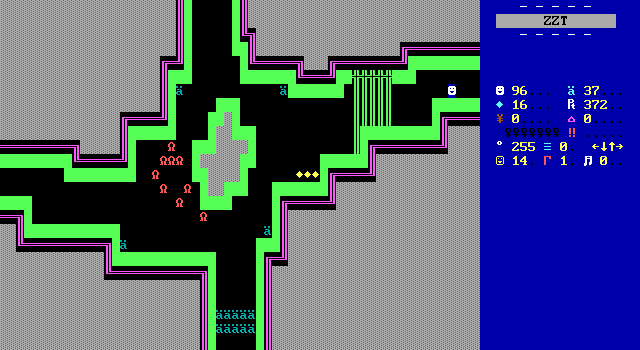
Sometimes the inspiration is hard to pin down. A lot of the vibes can be attributed to the early game using a level based structure like Monster Zoo. Little bits of on board text telling you to "HURRY!" and "ALMOST!" hearken back to the usage of text in Town.
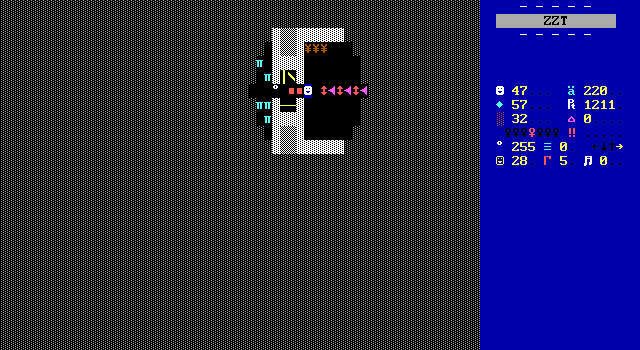
Other times you'll find yourself in a dark room with a set of three pushers blocked by sliders that send you through some conveyors into a small room filled with tigers. Hmmm....
I don't even object to the similarities. Steal from the best after all. There's no shortage of original ZZT adventures by new authors that set about to create their own kind of game and fail miserably. I'm an avid fan of the Link's Adventure trilogy. It takes more than wandering dark mazes and shooting ruffians to get a thumbs down from me.
Things just feel so bizarrely devoid of creativity and that's such a rarity for ZZT games, where often even the bottom of the barrel games can get you to crack a smile with some goofy artwork, bizarre writing, or just even bungling ineptitude. Secret Chambers frequently feels artificial in nature. It's got everything a shareware world inspired ZZT game needs, checking off box after box with no sense of how it feels when viewed as a whole.
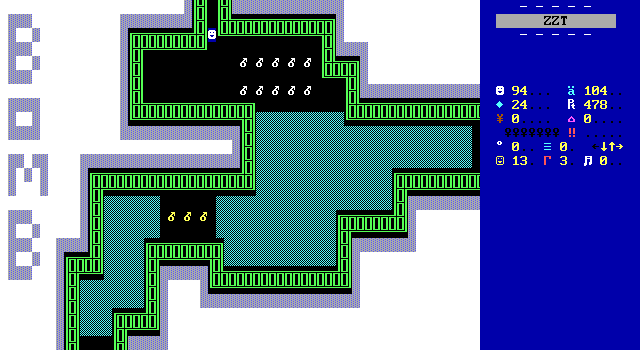
Bomb tunneling? Check.
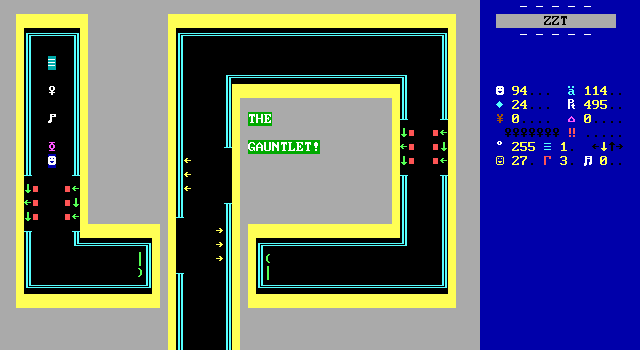
Blocking spinning guns with boulders? Check.
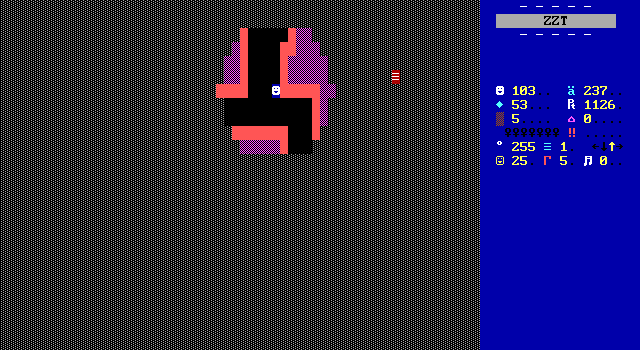
A multiple boards long maze with a limited number of enemies to engage the player? Check (unfortunately).

Key collecting puzzle? Check.
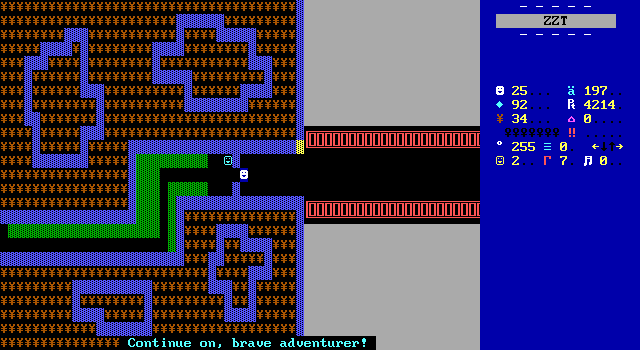
Bribing somebody to pass and being told to "Continue on, brave adventurer!"? Check.
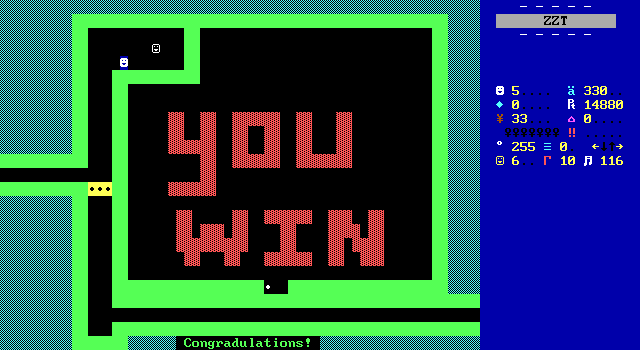
A celebratory speech for completing the game with large text appearing when the sequence starts? Check.
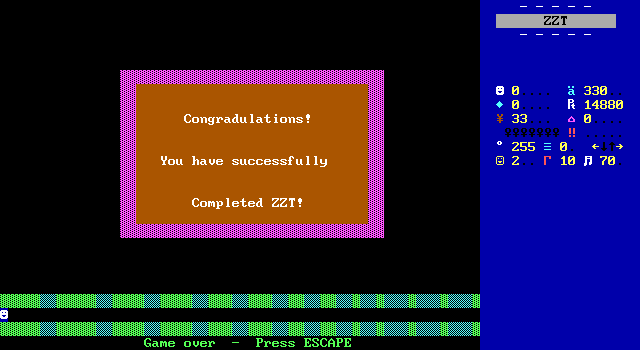
Walking onto the final board and having the game end with some more on screen congratulations? Check.
I hope I don't come off as too hard on this game. What it's doing isn't bad, just kind of boring. A die-hard fan of basic ZZT action can definitely have a good time in the first half of Secret Chambers, but I suspect the typical audience will get a little impatient at the very least. I enjoy a good classically styled ZZT adventure myself, it's just that there's a variety of options both new and vintage (etc. etc.) that do what Secret Chambers is doing in a more compelling way.
And while the sheer OG ZZT-ness never really stops, the second half of the game plays quite differently from everything seen here. Eventually, the Kopps are much more open to doing their own thing, and it definitely helps with the overall experience.
A Few Bosses
The level based structure lends itself to having a fight with a boss at the end. While Town has its battle with the dragons and Caves has the invisible viper, the original ZZT worlds mostly shy away from these kind of fights, using objects more to manipulate things on a board rather than run direct interference for the player.
The Kopps do like to add in a few of these, which are mostly "Move. Shoot. Repeat." in style.

Level one ends with a giant ogre. Nothing exciting here. There's no dialog or any surprises, just a foe that takes more than a few shots to go down.

Level two has no boss, but the Ruffian King here is the final obstacle for the third level. Getting to his chambers requires opening three red doors, with an annoying caveat of having to open them in the right order. It's entirely guesswork and the wrong answer prevents the door from ever opening. Not a good look.
Once you're inside, the Ruffian King is a bit more involved with a charging ability that makes them immune to bullets when rushing the player. He charges whenever the player is aligned with him so actually getting hits to register makes the fight a bit difficult.
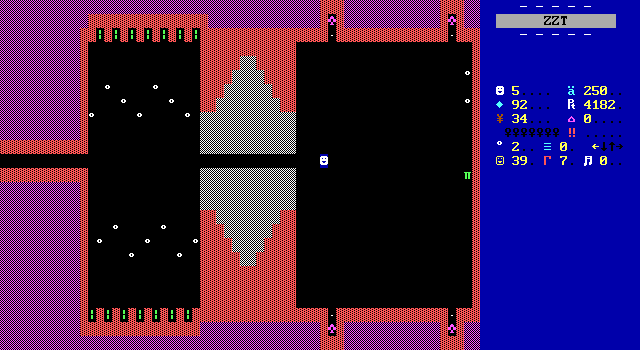
Royalty is the theme here with the Tiger King. (No, not that one.) He of course is surrounded by tigers ruffians. Compared to the Ruffian King, he's honestly a step back in terms of design, just reverting to basic moving and some slightly more aggressive than average shooting. The challenge here mostly comes from the limited health available throughout the game. It's one thing to beat him, but quite another to do so without taking any damage as I had to.
The fifth and final level has its own boss best left to that section itself. (Spoilers: It's not a king.)
The bosses aren't anything impressive, though all of them are competently coded and are at the very least more of a challenge than most boards. They also give the authors the chance to express some more original creations so I'm all in favor of them.
A Glimmer of Hope
Nothing about the lengthy list of classic ZZT references is to say the Kopps are completely devoid of original design. In the second half of the game, it's as if the two had an awakening, realizing that they don't have to hold themselves back to fit in with what ZZT games they've played before. Even before this happens, there's still some rare fleeting moments where there's hope yet for the two.

The second board of the game looks delightful! It's got such a weird background that makes the opening to the game very striking. It did somewhat remind of the surreal "WalkWay" portion of Caves, but it does this organically. Unlike much of the derived content, there's no single board to point to and say that's where they got it from.
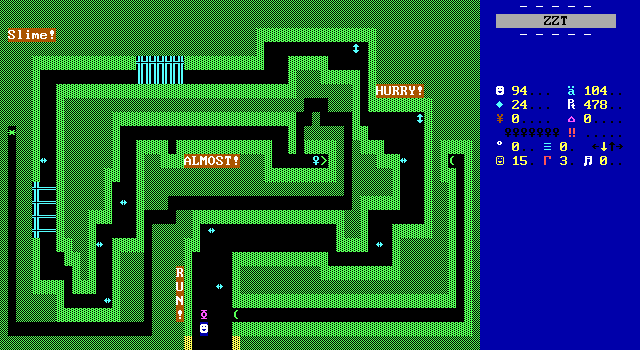
Using slime as a sort of time limit is nothing new sure, but you won't find it in Town or Monster Zoo. There's a sudden realization of what these slime things can be good for. The brothers seize the chance and make a fun little chase sequence with the player having to make split-second decisions as to whether or not they trust they can clear the blinkwalls in time or if they need to slam on the brakes and wait for the next cycle.
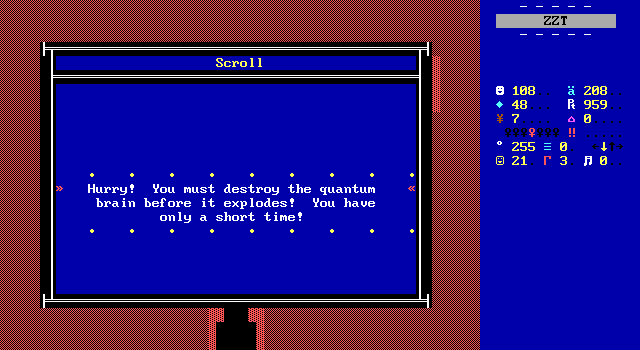
And that goofy writing? It still shows up now and again when the game isn't quoting Town.
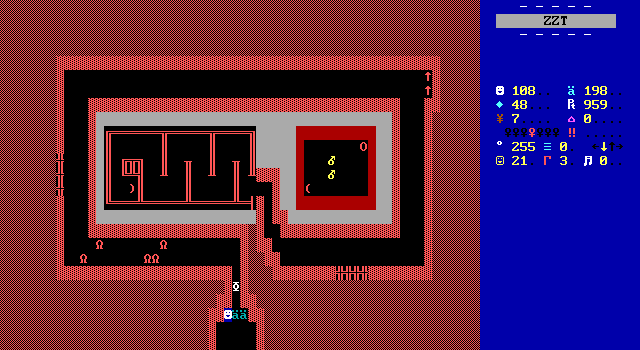
This is just an entirely out of nowhere timed board. The quantum brain is also entirely out of nowhere, having nothing to do with anything and existing solely as weird reason to limit the player's time. It pulsates in a corner waiting for the player to take it out with both bombs.
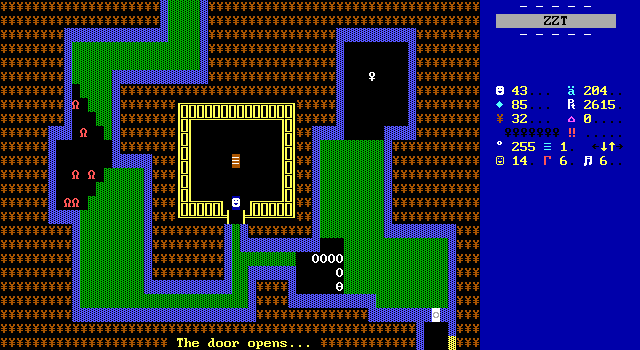
The entrance and exit to the fourth level has this elevator vibe to it? Am I crazy here for thinking this looks good?
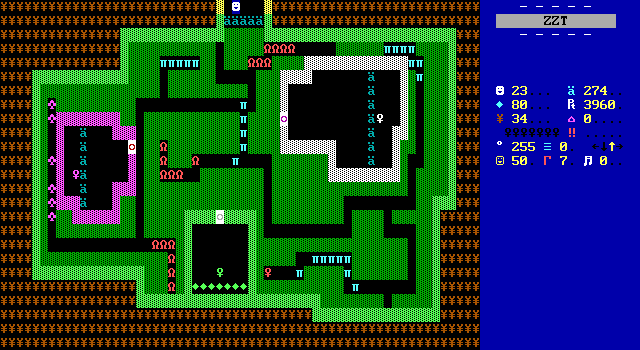
And sometimes, it is just as simple as a well-made board that's fun to shoot your way through. Putting all the enemies here onto the path rather than isolating them in forest makes this board a nearly free shootout. If you're willing to be patient, you can wait for enemies to come to you and take them out without fear of missing or being attacked first. If you get antsy and start rounding corners at intersections you're much more likely to have bad timing and get bit instead.
The enemies here are all at the default intelligence setting, which makes them difficult to predict how many if any will funnel around intersections and march towards your position.
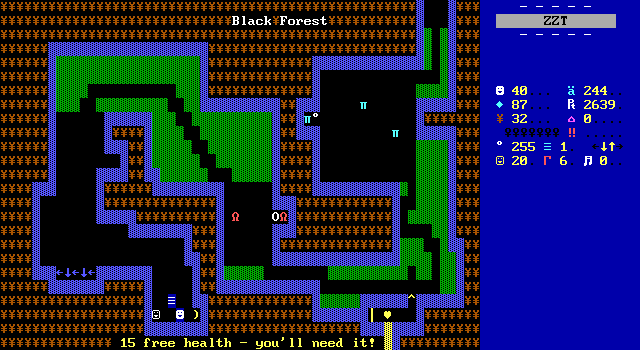
The game balance was also very solid. While this is arguably another instance of trying to mimic Town it's something that a lot of new ZZTers struggle with. As with Town and Monster Zoo health is sparse, acquired almost exclusively through gems. There are a few instances where bonus health is provided via objects, though it's not something to count on to save you.
Chambers ends up giving the player enough ammo that they can afford to be wasteful, yet not too wasteful. The player can comfortably shoot their way through board after board, ending most screens with more ammo than they entered it with. Once your health starts running low, you can compensate by being a little excessive on shooting to make sure nothing lasts long enough to get close.
Health, meanwhile, is the opposite. It should be no surprise that like a typical game of any of the original ZZT worlds, health is precious resource and once it gets low it stays that way. I fought for every gem I could just so I could safely survive one more hit. Secret Chambers offers a challenge that anyone with familiarity with the originals should be able to adapt to. If you have a particularly bad room, reloading might be worthwhile rather than dealing with being on the verge of death for quite some time, but that's the sort of situation you'll only really run into once or twice if you're not being stingy with your shots.
Alas, this is the rare game where it's torches that are a genuine problem. I perservered and finished the game without having to cheat for any health, even when it meant beating a boss or two without taking any damage. Torches were another story as Secret Chambers really loves to use dark rooms. They're usually stocked up nicely with torches to get through. Unfortunately, at one point there is a seven board long maze with several boards not offering any torches at all.
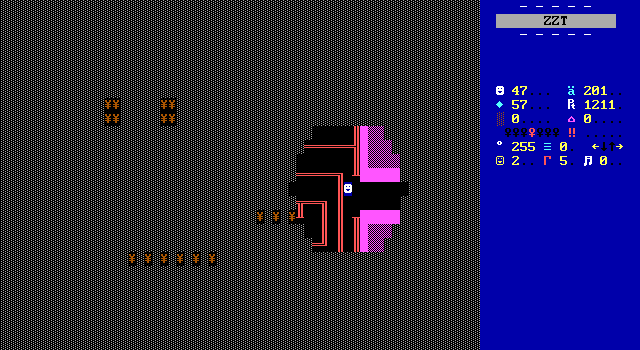
One board is intended to solve this problem, containing no enemies and a large cache to collect, yet it happens to be a maze within a maze. By the time I found it here I was burning my last torch and though the end was clearly in sight, all it took was one wrong turn to leave me stranded in the dark where I restored to just cheating for more.
Of course, since this board is all a part of a maze, simply running across it earlier probably would have been enough to get through it just fine. It's definitely possible to get through the entire game cheat free, but in this instance luck plays a significant factor into how likely that you can actually do so.
A Hint Of Something More
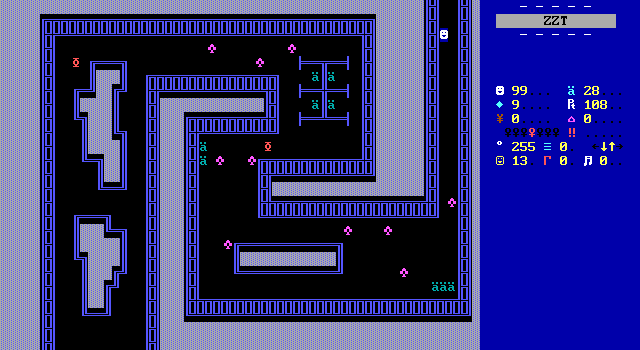
One other aspect of Secret Chambers that I did enjoy, but didn't quite work as well as it could have was the game's love of bonuses and secrets for the player to find. The introduction to these secrets is direct: a board just places a scroll telling the player to look out for hidden treasures. Sure enough, one of the little crevices players would have no reason to actually go out of their way to venture into holds an invisible object that provides both bonus points and a hint that something else in the level has moved.
The trouble mostly comes from the fact that a lot of these secrets are both few and far between and very much just invisible objects on tiles the player won't likely step on. Without anything amiss, there's no reason to comb through boards tile by tile hoping to get some extra score that only serves to place you higher on the game's high score board afterwards. Looking through the world there are a handful more instances of this, none of which I found, and this one would be no exception were it not for the scroll actually providing a hint to look more closely.
Secrets are tough! You have to hide them in such a way that the player can still find them. They have to provide benefits that make the player seek them out, but not be so helpful as to throw off the game's balance or worse, be essentially mandatory in order to balance an otherwise unbalanced game. Then you've got to put the player on the right track to know they exist in the first place!
Optional secrets are hardly a mainstay of ZZT, despite being there from the beginning. Sweeney's technique is one I'm surprised wasn't emulated as often, having the secrets share a board with some core gameplay. The abrupt and incredibly direct approach used by the Kopps isn't as organic, but I suppose it gets the job done.
Of course, if your secrets look like empties and not slightly off objects or geometry, then good luck finding them, or mustering up enough interest to try to.
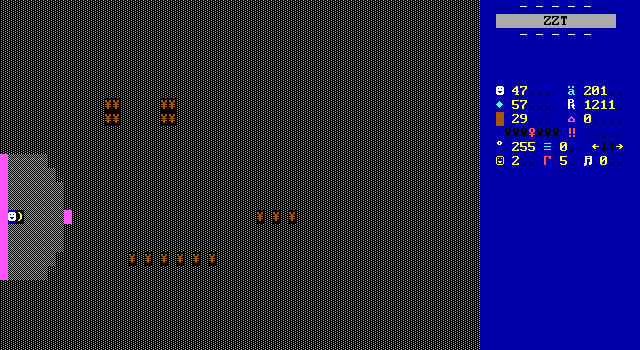
The authors do thankfully provide more than just lucky tiles to step on, but they only pull out the good stuff for the real secret of the game: the three treasures of virtue. The name chosen for this big secret made me wonder if things were going to suddenly pivot to some light Christian dogma, which since it's always so unexpected, I'd truthfully have gotten a kick out of it were that the case.
But no, the treasures of virtue just have a fancy name. That same maze I complained about running out of torches in holds a really neat secret where a transporter in the middle of the maze actually takes you outside of the maze and into what's normally the background area of the board. Something is clearly amiss but in darkness here though there aren't any clues provided for which direction to shoot to tunnel around the outer perimeter successfully making it up to the player to figure out what this is all about.

Tunnel properly and there's another hole in the wall that leads to a secret board that feels actually exciting to find! It's like a metaphor for the game as a whole, the first half is pure Town, but the second half creates something more original, memorable, and fun. (It's also normally dark.) A scroll at the start states that you're near the "ancient box of virtue", something that the player has no indication is in the game, or matters.
Proceeding to the lower half the game lets itself have a little fun with the design. The doors trap the player inside and the room begins to fill with a poisonous gas! The team opts to simply drain the player's health so again the experience can vary wildly depending on how injured the player is at this point. From there you get to solve a little puzzle of stopping the flow of gas and finding a way out that involves some levers, hoses, and salvation through refuse.
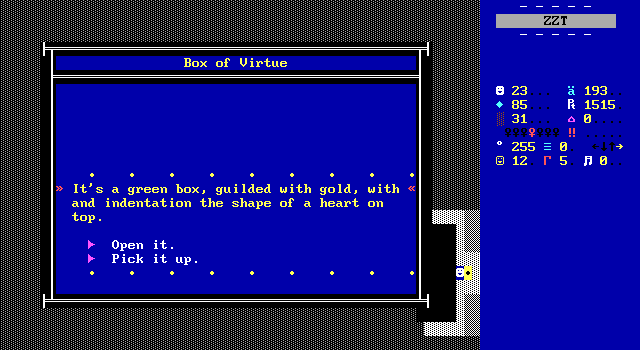
Find your way through and you can open or collect the mystical box. I really get the sense that the game's authors felt these secrets were truly the most important thing in the game. This kind of descriptive writing for the box is rarely seen otherwise. (It is also yellow not green, which I find amusing.)
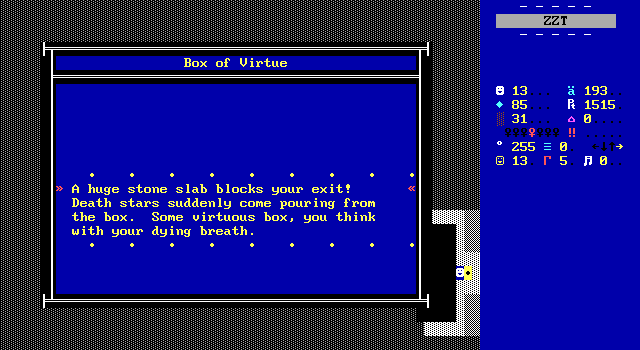
Well, okay, there is some morality at play here. This instant game over for opening the box simply has to be shared.
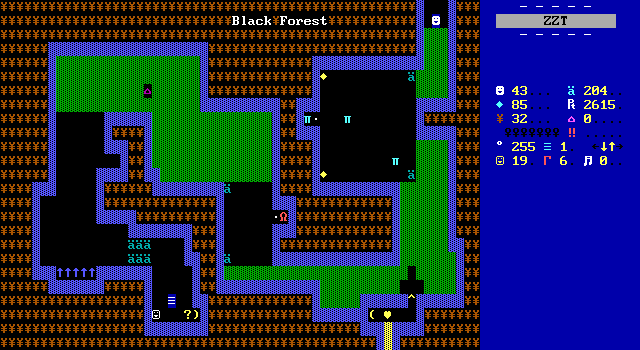
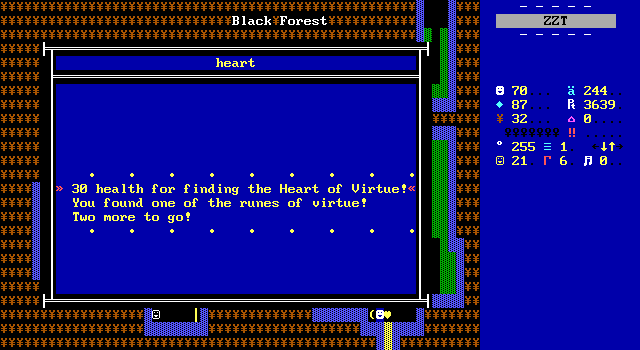
A forest board later on contains the Heart of Virtue. This one isn't really a secret as it's in plain sight at the end of a basic action board. Instead it tempts the player by requiring them to run through most of the board a second time if they want to examine the heart object, which since the player gets an energizer for the first run through some spinning guns, does a nice job of making it a decision the player needs to weigh for a moment.
Granted, it's a heart, so even though players won't actually know what purpose it serves until they touch it, there's enough of an established convention in ZZT that there will be an instinct to collect it just for some health. Kudos to the Kopps though for also providing health from the heart as well in case any desperate players were willing to cross the board again hoping to escape with more health than when they first reached the exit.
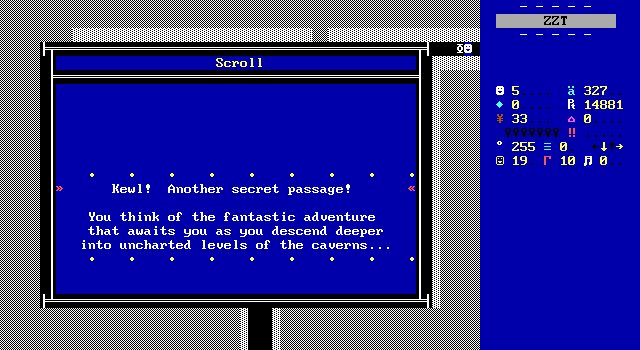
The final treasure as presented here is actually the first one! It can be very easily missed since there's no idea that secret treasures are a part of Secret Chambers at this point. Reaching this piece requires finding that hidden treasure hinted at by the scroll that marked the start of this section, but then doubling back to find out what it actually did.
This is a totally valid way to hide the secret in general, but because this is so very early into the game I figured it was just as likely that that next board would have a door that would only open when the treasure was found. When I saw nothing amiss I didn't think twice about whether there was something odd about any of the earlier boards.
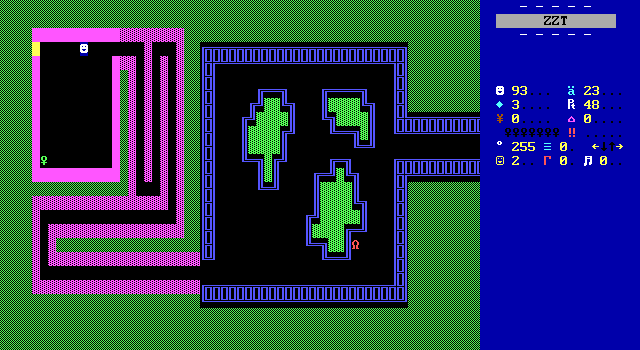
Which, I mean there was. That wall is hardly inconspicuous but even with a HUD telling me there was even a board connected to this, the design of it as it was and the lack of a message when touching it made me assume it was just a mis-colored wall, not as a clue, but as a genuine mistake.
The authors of Secret Chambers mark objects in walls like this constantly. Seeing any mis-colored wall doesn't mean it's something the player needs to touch, but it almost certainly is something that is going to be monitoring the player's progress in some way.
The Caves of Logic

The first half of Secret Chambers just doesn't feel like the authors have a chance to do what they want to do, which is silly because of course they did. It's just that what they wanted to do was what Sweeney and Pilgrim had already done. These secrets exist to break the player out of the main game and get a lot more room to be something unique. There's definitely meant to be a whole bunch of mystique and intrigue around these secrets. I feel like the authors were too young and/or inexperienced to properly build up the atmosphere they're going for, but it's still night and day compared to the main levels.
Of course you have your ancient language of a long forgotten people. A little Caesar cipher where the clues are just pre-translated messages. The challenge comes from them really being on scrolls so your reference material vanishes quickly.
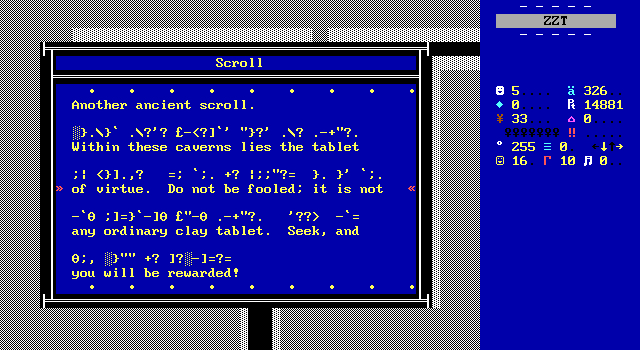
Eventually, the scrolls stop arriving pre-translated. The only problem here is that because they were all being translated at first, I didn't bother writing the code down.
| A | B | C | D | E | F | G | H | I | J | K | L | M | N | O | P | Q | R | S | T | U | V | W | X | Y | Z |
| - | + | £ | = | ? | | | [ | \ | } | > | " | { | ` | ; | ~ | ] | ' | . | , | < | ░ | Θ | ||||
| 1 | 2 | 3 | 4 | 5 | 6 | 7 | 8 | 9 | 0 | Characters with a yellow background must be deciphered based on context in untranslated scrolls. | |||||||||||||||
| ! | @ | # | $ | % | ^ | & | * | ( | ) | ||||||||||||||||
The remaining messages provide some hints for the puzzles, which conveniently include quoting text from Town, which I guess makes sense seeing as how one of the boards also quotes Caves, providing the only evidence that these authors had access to registered ZZT worlds as well. (This is a 1997 game after all, the year they were all freely released.)
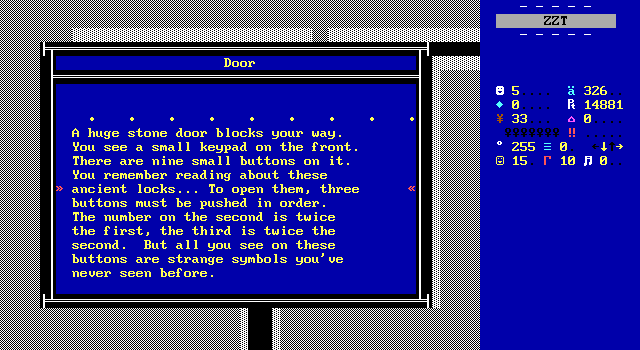
This part of the game is fittingly full of simple logic puzzles. The first requires deciphering the numbers in this ancient script with only "1 = !" as the only reference. It's enough that the first guess you'll come up with of shift+# on a keyboard is the correct one, but it really is a guess at this point when you only have one point of data to establish a pattern with. Upon entering the second board you'll get a "Caves of Logic - Room 2" scroll that confirms the hypothesis that had to be confirmed in order to read it.
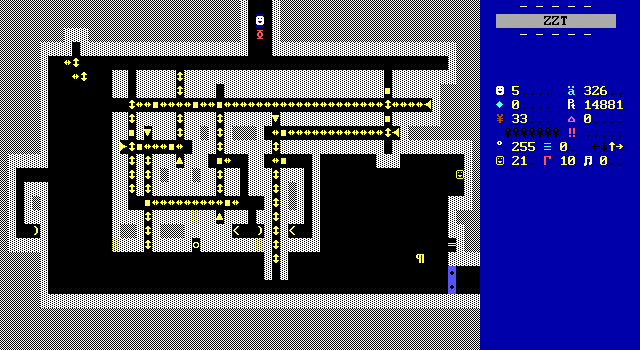
The logic puzzles are fine, but the rest of the puzzles less so. These yellow circular objects are meant to be sensors that trap or kill the player if the cross. One of the scrolls explains them to have a weakness of not functioning if they're directly blocked, requiring the player to place a boulder directly next to them to get through. The wording is a bit off making it sound like the solution may be to move past them with the player blocking the sensor for that brief moment, and sure enough this does work... sometimes.
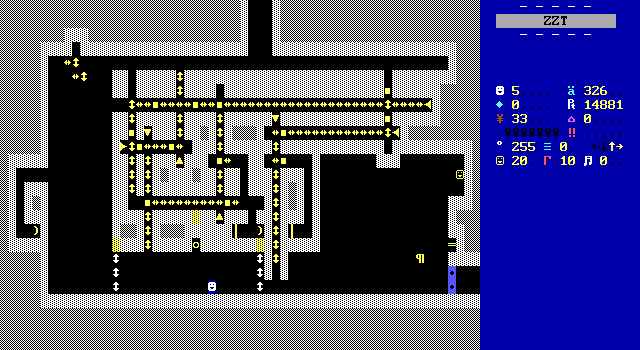
But it worked when I tried it so I assumed it was the intended solution for a bit.
Instead, it's just a side effect of stat order allowing a quick enough player to run past the sensor before it's properly tripped. This means several puzzles can be skipped outright, and with my lack of love for slider puzzles, I was happy to get away with it.
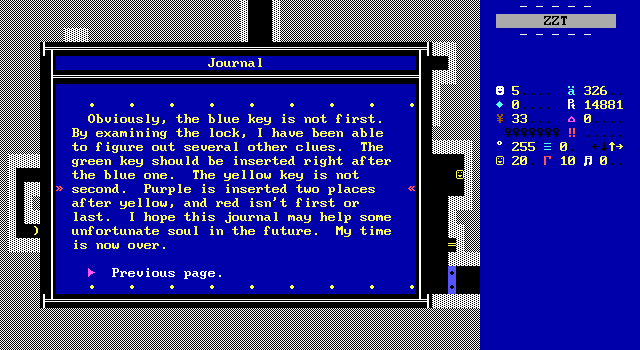
The non-slider puzzles are pretty enjoyable though and a highlight of the game. They are definitely the sort of thing you'd find in a "101 puzzles and riddles for kids" activity book sold to grade schoolers, but I found myself enjoying taking little notes with a pen and paper to figure out the order to insert some keys.
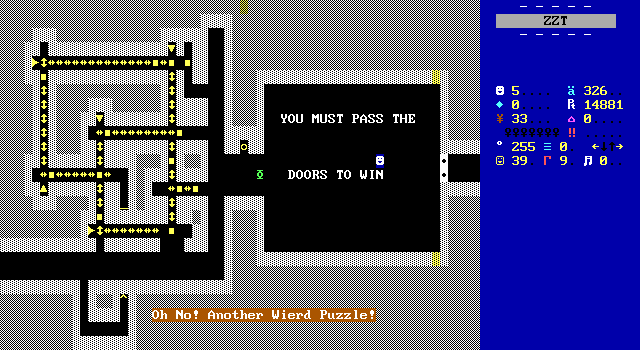
The last one though was to my knowledge wholly original (even if the label on the board is not). Text in the final chamber explains things clearly enough, but what you're supposed to do to get past the doors is another thing.
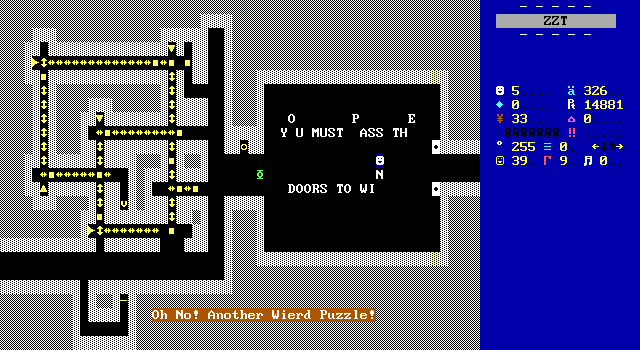
Touching any of the letters will cause it rise. Pick out the letters O P E N and the doors open! I thought it was clever, though again the communication wasn't quite as clear as I'd have liked. At one point I touched an O in "DOORS" thinking that any O would do. I get that this way has the letters appear left to right, but with the layout of the room being what it is, I can only hope I'm not the only one who would've just assumed one letter is as good as any other.
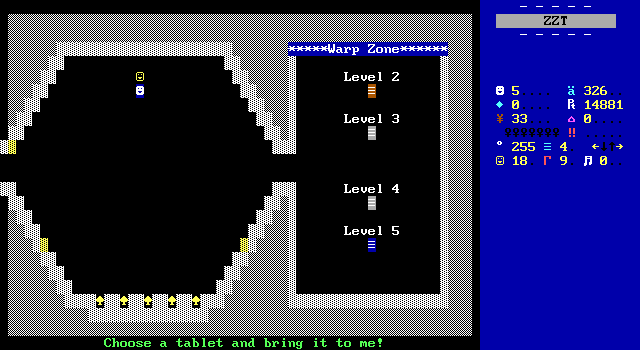
The final puzzle is to present a tablet to the guardian here and find the true Tablet of Virtue.
Now my childhood was spent watching Indiana Jones films regularly, so I went into this one feeling like I had the adventuring experience required for this sort of thing.
A golden tablet with strange inscriptions
on it. There is little dust on it. It is
large and wide, and it is in the shape of
a square.
A silver tablet with strange inscriptions
on it. There is a heavy layer of dust
covering it, as if it has lain there for
centuries. It is large and round.
A clay tablet with strange inscriptions
on it. There is a heavy layer of dust
covering it, as if it has lain there for
centuries. It's shape is a small square.
A silver tablet with strange inscriptions
on it. There is little dust on it. It is
small, and is in the shape of a square.
A clay tablet with strange inscriptions
on it. There is a heavy layer of dust
covering it, as if it has lain there for
centuries. It's shape is a small circle.
• • • • • • • • •
Five tablets were offered made up of gold, silver, and clay. Two of them were clay so I was admittedly not as confident as I was before looking at them. Sure enough, I chose poorly.
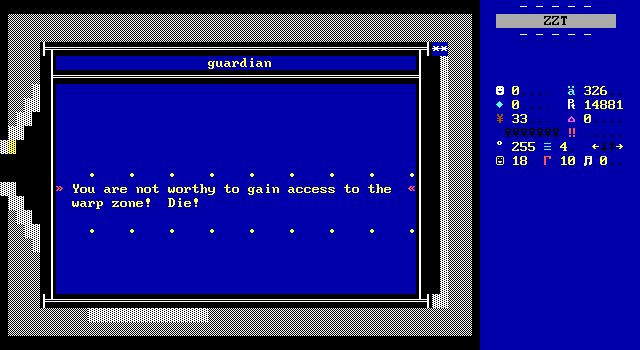
In fact, it's not one of the clay tablets at all. It's the round silver tablet. As far as I can tell, this is genuinely just a blind guess. None of the scrolls or anything else in the game offered up any relevant information to even eliminate a single wrong choice, let alone figure out the correct tablet.
When you do choose correctly, instead of dying, a path opens up to the "Warp Zone", something the level based structure of the game gets the benefit of being able to offer. Of course, if you want to get the heart and tablet as well you can't warp to the later levels. I guess this is a way to jump straight into the second half of the game that I've been talking up as being more original. That entire section of the game is just "Level 5" here.
If you manage to get the tablet from level one, the box from the the secret in level three, and then collect the heart in level four, you can collect your reward. The heart will open up a path to another hidden board filled with treasure.
Nothing actually stops the player from traveling back to earlier levels as it's all connected via passages. It's possible to instead get the heart and box, and then get the tablet here which results in a special message indicating that there's a secret on the last board of the game for those that have collected the treasure.
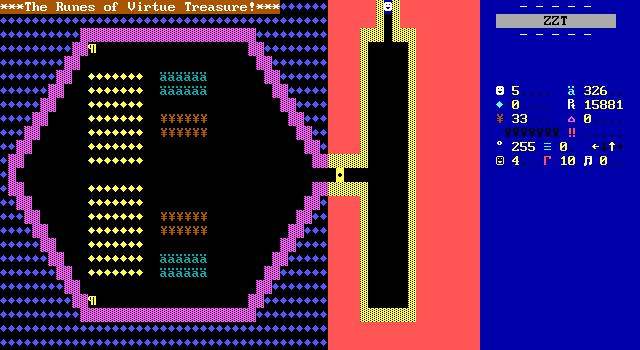
The treasure is ultimately a letdown, but that shouldn't be a surprise. Not because of the quality of the game, but just because it's a traditional ZZT adventure. It's points and supplies or nothing.
Humorously, opening the door involves combining the pieces before opening the box, but you can still open it early and once again be killed by stars. Until the end of the game, all this extra work and secret digging is just to get a whole bunch of gems and reasonable amount of extra ammo and torches. (You can touch a wall to get the blue gems as well, or start on the outside if you reach this board from the Caves of Logic rather than the heart board.)
Though I will say, the music when you open the door is surprisingly well done, and worth a listen.

